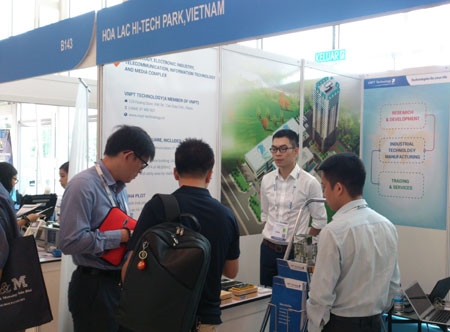 Economy
Economy

Vietnamese semiconductor firms should roll with the region's players to build up a local ecosystem and move up the regional supply chain, officials at Semiconductor Equipment and Materials International (SEMI) have said.
 |
| Visitors looking at technology products developed by VNPT Technology at SEMICON Southeast Asia 2016 in Malaysia. – Photo VNPT Technology |
by Mai Linh
PENANG, MALAYSIA – Vietnamese semiconductor firms should roll with the region’s players to build up a local ecosystem and move up the regional supply chain, officials at Semiconductor Equipment and Materials International (SEMI) have said.
They should do so in order to tap into the country’s growth potential, as Việt Nam is now being recognised as an emerging player, according to the global trade association which serves the electronics manufacturing supply chain.
Speaking with Việt Nam News on the sidelines of the three-day semiconductor industry exhibition SEMICON Southeast Asia 2016, which opened in Malaysias Penang on Monday, Ng Kai Fai, president of SEMI Southeast Asia, said it was now necessary for Vietnamese firms to get more connected with the regional semiconductor supply chain and to play their increasingly important roles.
The association, in a news release in early April, said the Vietnamese semiconductor industry was expected to grow at a compound annual growth rate of 14.3 per cent by 2019, an impressive rate for an emerging player amidst a slight drop of 0.2 per cent in worldwide semiconductor revenues last year.
The modern era of technology-driven transformation with the Internet of Things (IoT) and growing demand for electronic devices has generated opportunities worth many billions of dollars for the global semiconductor industry, the technology innovation forum, part of SEMICONs agenda, heard.
"Local semiconductor firms should now extend their network beyond their borders to take advantage of the trend," Fai said.
"Still, I see some reluctance among local semiconductor firms in promoting co-operation with regional and global players and in pursuing new technology trends," Fai said.
Local firms have seemingly been left behind from the regional dynamic semiconductor development by established players such as Singapore, Malaysia and Thailand. This will continue if no improvements are made.
The reasons for the reticence were partly rooted in the local firms’ uncertainty over strategies to push past borders and partly due to the lack of a comprehensive development strategy from the government to promote the semiconductor industry, according to Fai.
Although Việt Nam finds itself at the cusp of becoming an important electronics exporter within the region, with a 38 per cent share of the global electronics industry (2014), SEMI said local electronics players were unable to take advantage of the ballooning electronics exports.
Fai said Việt Nam made a huge jump in the 2009-14 period in the earnings from electronics exports, rising from some US$9 billion to $35 billion, but a large portion (roughly 90 per cent) of this revenue came from foreign direct investment (FDI) firms.
In fact, Việt Nam has great potential to develop the semiconductor industry, especially in integrated circuit manufacturing, according to Fai.
"You have a huge market, young labour force and willing engineers, in addition to a driving force coming from the influx of FDI," he said.
It is now critical for local firms to be more active in enhancing co-operation with regional and global players and to learn and adopt advanced technology trends, develop the semiconductor ecosystem and move up the value chain, Fai said.
He added that joining SEMICON, which attracted more than 200 global exhibitors and estimated 7,500 visitors this year, could be an opportunity for local firms and start-ups to promote collaboration with the region.
Việt Nam needs transparent policies and a clear strategy to encourage the advancement of local semiconductor firms, in addition to education programmes that get universities to work with industrial associations to build the right talent pool for the industry’s development, he said.
"Talent is of great importance to the development of the semiconductor industry and in technology transfers," Fai said. "Don’t expect to see immediate effects. It will take time for Vietnamese semiconductor players to move up the regional supply chain."
Singapore-based financial services group DBS, in a report on the Vietnamese electronics industry published in early July 2015, said Việt Nam’s electronics sector was fast catching up with the regional powerhouses and would soon overtake Singapore to become the fifth largest electronics exporter in the region in the next two year. The report also noted that moving up the value chain and developing local talent would be crucial going forward.
The country was on its way to reaching an electronics export value of $40 billion by 2017.
These are the early efforts being made by Vietnamese firms to create connections with regional and global players in this space.
SEMICON Southeast Asia this year drew the participation of VNPT Technology, a member of State-owned Việt Nam Posts and Telecommunications Group. VNPT Technology, with support from Hòa Lạc Hi-tech Park, was the only Vietnamese semiconductor player to join the regional platform SEMICON to seek out co-operation opportunities.
SEMI Southeast Asia said it was working with associations and agencies in Việt Nam, including Hòa Lạc Hi-Tech Park in the north and Sài Gòn Hi-Tech Park in the south, to promote the involvement of local semiconductor firms in the regional manufacturing supply chain.
Still, greater efforts are needed. "They have to do more," Fai said.
While FDI influx will remain important to the development of Việt Nam’s semiconductor industry, Nguyễn Trọng Hiếu, vice director of the Hòa Lạc Hi-Tech Park Management Boards Investment Department, told SEMICON attendees that the park was a good destination for semiconductor investment.
As the largest hi-tech park in Việt Nam, it is strategically located near the capital city of Hà Nội and Nội Bài International Airport. It has a fully developed infrastructure and provides the highest investment incentives as well as one-stop administrative services.
For the semiconductor industry, Việt Nam is emerging with plans for a new a 200mm wafer fabrication manufacturing project in addition to its existing assembly, testing and packaging services, according to SEMI.
The semiconductor product in 2012 was listed among nine national key products under the national product development programme by 2020. — VNS




